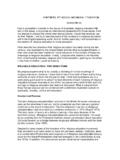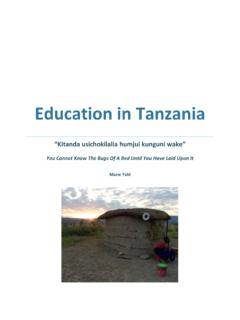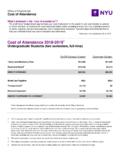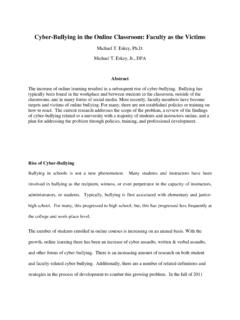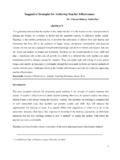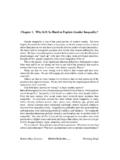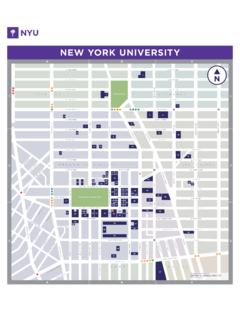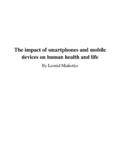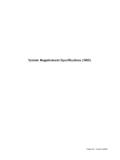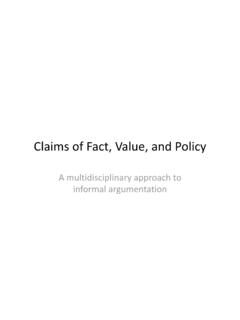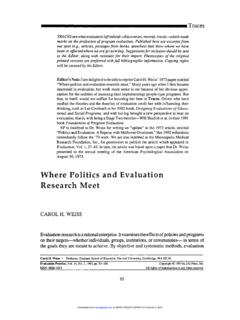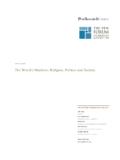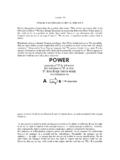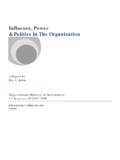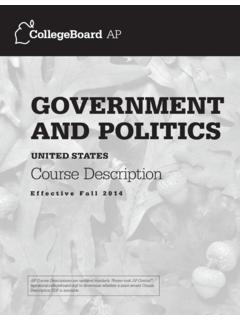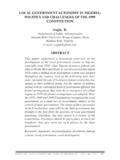Transcription of PERSISTENT MEDIA BIAS - nyu.edu
1 Research Paper No. 1845 PERSISTENT MEDIA BIASD avid P. BaronStanford UniversityFebruary 2004 AbstractThe news MEDIA plays an essential role in society, but surveys indicate that the mediais widely viewed as biased. This paper presents a theory of MEDIA bias that originateswith private information obtained by journalists through their investigations and persistsdespite profit-maximizing news organizations and rivalry from other news has two effects on the demand for news. First, rational citizens are more skeptical ofpotentially biased news and thus rely less on it in their individual decision-making. Second,bias makes certain stories more likely than others. This paper presents a supply-side theoryin which bias originates with journalists who have a preference for influence and are willingto sacrifice wages to exercise it.
2 News organizations can control the bias by restricting thediscretion allowed to journalists, but granting discretion and tolerating bias can increaseprofits. Citizens have a demand for news they can use in their everyday lives, but theirskepticism reduces demand and leads the news organization to set a lower price for itspublication the greater is the bias it tolerates. Lower quality news thus commands a lowerprice. Bias is not driven from the market by competition from a rival news organization nora news organization with an opposing bias. Moreover, bias can be greater with competitionthan with a monopoly news organization. If citizens collectively choose regulation in placeof their individual decision-making, bias increases the stringency of MEDIA BIAS1 David P.
3 BaronStanford UniversityI. IntroductionThe news MEDIA plays an essential role in society by providing information to the public forboth individual and collective decisions. The news MEDIA , however, is widely viewed as biased. Asurvey by the American Society of Newspaper Editors (ASNE (1999)) revealed that 78 percent ofthe public believed that there was bias in news reporting. There, however, was little consensuson the nature and direction of the perceived bias. This paper identifies a demand for news anda supply of biased news. MEDIA bias has bothex anteandex post, when readingnews stories citizens take MEDIA bias into account and are skeptical of news reports that might bebiased. This makes them more cautious in acting based on the ante,mediabiasaffectsthe probability that particular stories are reported, which can increase the likelihood that citizensact based on the news.
4 News MEDIA bias thus affectsboththecontentofstoriesandalsowhi chstories are reported. Bias and the resulting skepticism reduce the demand for news, which leavesthe issue of whether profit-maximizing news organizations would tolerate bias in their news reportsand whether bias would persist with competition among news bias could have a variety of sources. Bias could reflect the preferences or world viewof the owner of the news organization. At least in the United States, however, major news orga-nizations are owned by corporations, and the market for control should lead those corporationsto maximize profits rather than follow personal views. MEDIA bias could also have demand-sideexplanations. Citizens have a demand for newsasentertainmentandmayhaveademandfors tories that are consistent with their political or social views.
5 The latter in particular may providean incentive for a news organization to bias stories to cater to particular clientele. Similarly, anews outlet that relies on advertising revenue may cater to high-income explanations are based on characteristics of potential subscribers. In contrast,this paper provides a supply-side explanation for the existence and persistence of MEDIA bias basedon incomplete information and the career concerns and preferences of journalists for discretion to journalists allows them to bias stories and also allow a news organization1 This research was supported by NSF Grant No. SES-0111729. I would like to thank TimGroseclose, James T. Hamilton, Emeric Henry, and Paul Oyer for their hire at a lower wage than if journalists were tightly monitored.
6 The supply-side explanation isbased on the availability of potential journalists who are willing to work for lower wages in positionsin which they can advance their careers or influence the public by exercising the discretion grantedby a news organization. For example, Stern (1999) found that the wages of scientists who workedfor pharmaceutical companies that allowed their scientists to publish their research and attendconventions were lower than the wages paid by pharmaceutical companies that did not providethose opportunities for their a rough indicator that journalists may accept lower wages, suppose that journalists arealso qualified for jobs in advertising and public relations. The Bureau of Labor Statistics, Occupa-tional Employment and Wages 2002 Survey, indicated that the average wages for News analysts,reporters and correspondents was $39,160, $46,590 for Public relations specialists, and $55,710for Advertising and Related Services.
7 The average 2002 wages for Newspaper, book, and di-rectory publications editors was $46,410 and $41,270 for Radio and TV broadcasts , many news organizations use interns, some of whom are unpaid. In the model, journal-ists accept lower wages because they want to have influence; , to lead citizens to take greaterprecautions against potential hazards than they would otherwise take. Or, the journalist may havecareer concerns that can be advanced by having her stories published, and biasing stories couldincrease the probability they would be the model even though they remain skeptical of possibly biased news stories, citizens havea demand for news because news reports provide information on which they may base individualand collective actions. Skepticism, however, causes the MEDIA organization to set a lower price forits news service, and a profit-maximizing news organization tolerates bias only if it gains more onthe supply side than it loses on the demand side.
8 Tolerating bias is shown to be consistent withprofit maximization. Competition from a news organization with less bias could, however, forcethe higher bias organization to reduce the discretion granted to its journalists. Bias, however, isshown to persist with competition between like-oriented news organizations, where citizens choosebetween competing publications based on their risk aversion. Moreover, the news organizationwith the greater bias can have higher profits. Bias can also persist with competition betweentwo news organizations with opposing biases; , one biased toward influencing citizens to takemore precautions and the other biased toward fewer precautions. An example demonstrates thatthe news organization with the greater bias has a lower price for a subscription but can havehigher profits.
9 Moreover, competition can result in more biased news than with a monopoly MEDIA bias can affect both public and private politics . Public politics involves individualand collective action directed at public institutions such as legislatures and bureaucracy. Privatepolitics involves individual and collective action directed at private parties often in the arena ofpublic illustrate the distinction consider the issue of genetically-modified organisms(GMOs) in foods. Private politics could involve action by activists attempting to lead citizens totake precautions against GMO foods and boycott producers and retailers so that others will notbe exposed to such foods. Public politics could be directed at Congress to ban or require labelingof GMO foods or at the Food and Drug Administration to regulate GMO incentives for citizens to read a newspaper, listen to the news on the radio, or watcha television news program are unlikely to come from public politics .
10 The probability that anindividualispivotalinanelectionorininf luencing government in office is very small, as Downs(1957) argued. A citizen could have a demand for news because of its entertainment value orsimply to be better informed. Another explanation, however, can be found in the private decisionsof citizens. That is, the news can help citizens make better decisions in their everyday lives. Thosedecisions could pertain to health, safety, personalfinance, product selection, employment, or otherissues about which citizens have incentives to make purposive decisions. The perspective here isthat demand comes from news citizens can principal focus thus is on private rather than public politics , and to simplify the analysisthe emphasis is on precautions taken by individuals, as in the case of GMO foods.
